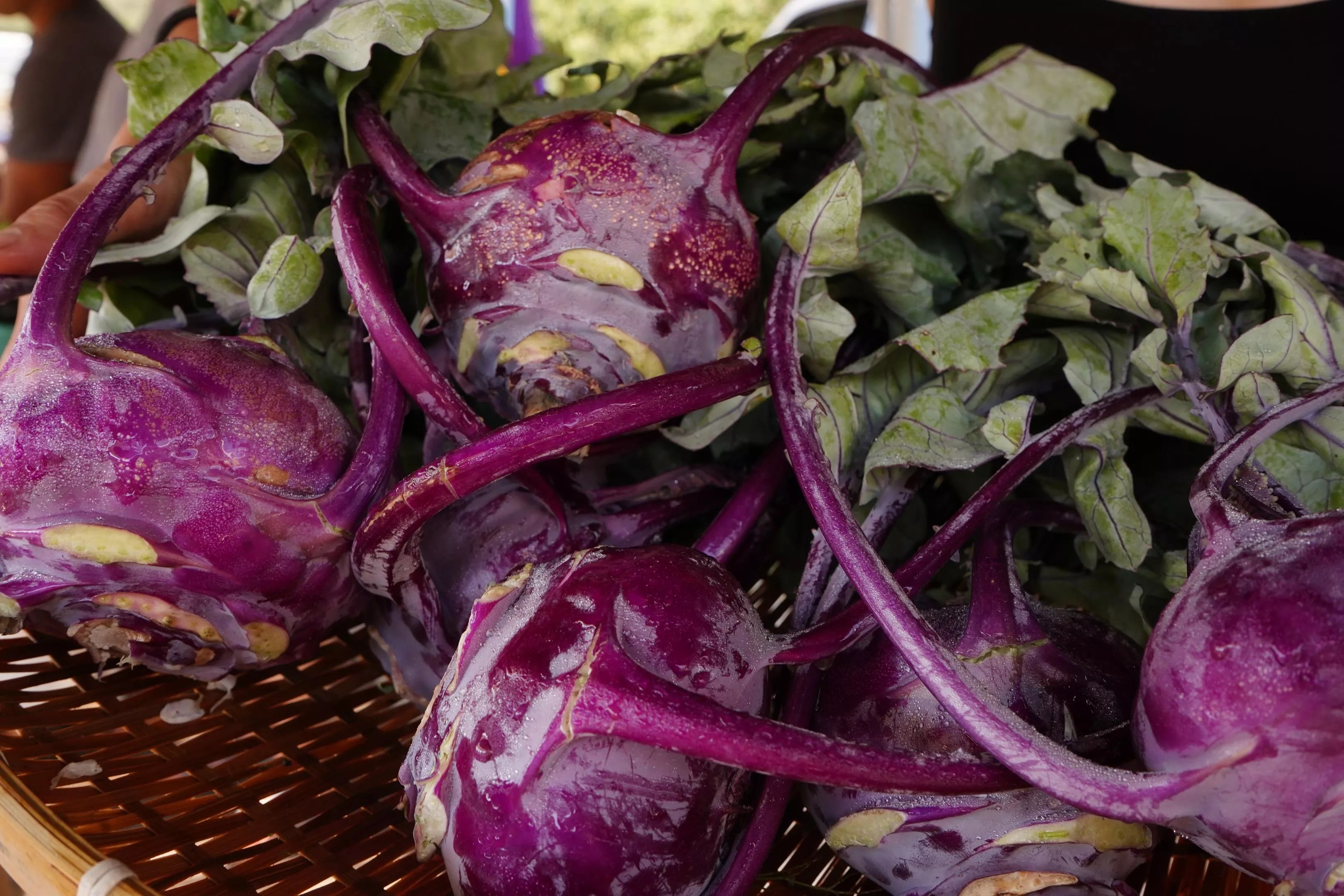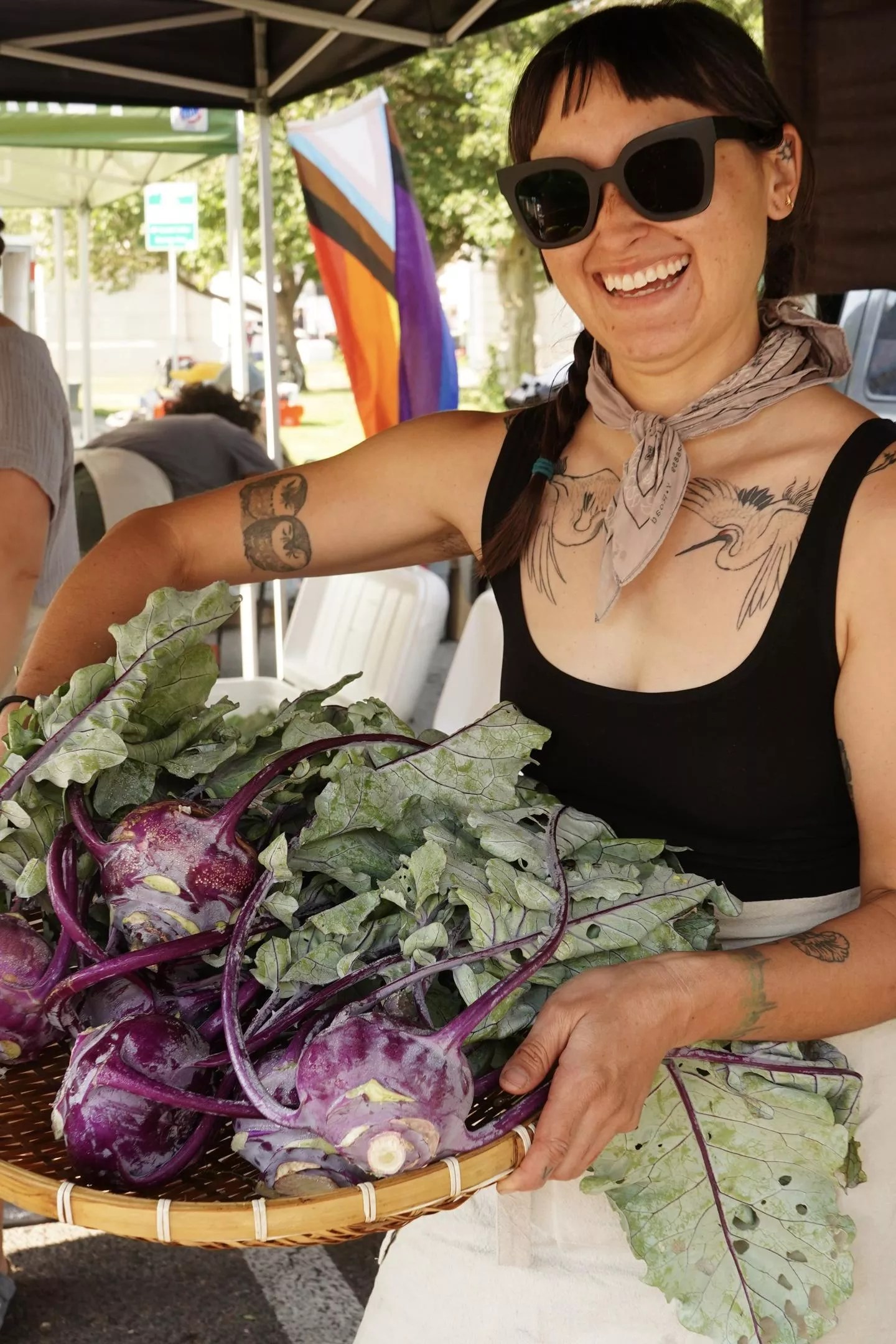
Minrou Farm

Audio By Carbonatix
Last year, Coperta chef and owner Paul Reilly declared haruki turnips the most underrated summer produce in the state. This year, the owner of one of the city’s top markets is weighing in with a new contender: kohlrabi. Margo Wanberg and her husband, Peter, co-own the City Park Farmers Market, which takes place every Saturday from 8 a.m. to 1 p.m. through October. Here’s her take on this vegetable, and a recipe to try if you pick some up during your next market outing (which you definitely should):
With its bulbous body and swollen stems, you may be deterred by the alien-like features of the kohlrabi as you scan the mounds of produce at your local market. Odds are you didn’t grow up munching on this underrated vegetable at the dinner table, and it’s probably not the first thing on your mind when grocery shopping (if you can even find it at the grocery store). But I’m here to add the kohlrabi to your list as one of Colorado’s most versatile and hardy vegetables. Learn what it is, how to cook with it, and add it to your roundup of market essentials. You’ll thank me later.
The kohlrabi is a member of the brassica family, and it has deep German roots. “Kohl” means cabbage while “rabi” translates to turnip. It is truly a magical combination of these two delicious, nutritious and humble vegetables. To the surprise of many, the kohlrabi is not a root veggie; its green or purple body is actually just an enlargement of the swollen stems that grow off of it.
Denver, make your New Year’s Resolution Count!
We’re $17,500 away from our End-of-Year campaign goal, with just a five days left! We’re ready to deliver — but we need the resources to do it right. If Westword matters to you, please contribute today to help us expand our current events coverage when it’s needed most.
When harvested correctly, the kohlrabi is tender, slightly sweeter than your average turnip, and provides a nice peppery flavor. The adaptability of the kohlrabi is easily unrivaled: Eat it raw, baked, boiled, cooked, puréed or grilled. You can do no wrong!
During a recent morning walk around the market, I stopped to admire a stout-looking pile of vegetables at the Monroe Organic Farms tent. Sam Caplan, a farmer with Monroe, saw me eyeing the produce and said, “Kohlrabi is such a vastly underrated vegetable. I feel like it’s a love union between a cabbage and an apple. It has the practicality of the cabbage with the sweetness and crunch of the apple.”

Jade Sato of Minrou Farm carrying a haul of kohlrabi.
Minrou Farm
When farmers choose what to grow in Colorado, they have some unique challenges to consider. With a range of elevation across the state, the arid climate, fluctuating temperatures, water restrictions, wildfires, high winds and much more, it seems almost impossible to farm here, and yet our local farmers continue to prevail and provide. Whenever I travel to lush places, I often think about how brave and persistent Colorado farmers are.
Given some of the climate obstacles we have, it’s important that farmers choose to grow items that can thrive, and the kohlrabi does just that. It’s a vegetable that flourishes in our dry climate, making it ideal to grow in the Centennial State.
Farmers are not the only ones singing the praises of the kohlrabi. Due to its adaptable nature and structure, chefs all over town utilize the kohlrabi in a variety of ways. In fact, this un-presuming vegetable may be one of Colorado’s best-kept produce secrets.
James Beard Award-winning chef Caroline Glover of Annette plates a roasted kohlrabi and maitake dish every fall and chops them raw to put in salads. “Kohlrabi is definitely an underrated vegetable,” shares Glover. “We use it at Annette for a few different dishes when it’s in season. … It’s one of those special veggies, as it can blend in so well and take on the flavor of another ingredient in your dish, or hold its own and be the star of the show.”
To select the perfect kohlrabi, consider how you plan to consume it. If you enjoy eating kohlrabi raw or shredded in salads, shoot for smaller, less mature bulbs the size of a tennis ball. Considering puréeing or baking it? Aim for a baseball-sized kohlrabi, as it tends to hold structure better. When scanning the piles of kohlrabi at the market, look for fresh leaves and stems with tighter skin. Leaves that are yellow or wilted indicate that the kohlrabi was probably harvested a while ago, so purchasing this vegetable from local markets around town is key.
Although it’s uncommon to even see kohlrabi in bulk grocery stores, they are abundant at farm tents across the state from June through October. Kohlrabi, like the majority of produce items, has the best flavor and most nutrients when picked ripe and eaten fresh. Local farms such as Croft Family Farm, Minoru Farm, Delaney Farm, Wild Wick Farm, Switch Gears Farm and Monroe Organic Farms, to name only a few, all have fresh kohlrabi in piles sprawled on their market tables throughout the season.
Have I convinced you to join the kohlrabi fan club? At this point, I hope you are at least considering yourself an interested party. If you need an excuse to venture out of the house this weekend, my advice would be to take a stroll through your local market, grab a kohlrabi from a farm tent (thank your farmer), and try the kohlrabi out for yourself. My guess? It will be love at first bite.
Shermie’s Kohlrabi Skyr Salad
David “Sherm” Sherman is a local market legend who was once a market runner for top chefs in New York and is now a staple at markets in Denver. “I’ve served this to kids, celeb chefs and the Prince of Denmark, and they all love it,” he says. Who can argue with that?
Put all this in a big bowl:
1 kohlrabi (grated)
Kohlrabi greens (diced)
1 red onion (sliced)
Mint (rip it up and throw it in)
Skyr/Greek yogurt (big ol’ scoop)
Apple cider vinegar (to taste)
Olive oil (to taste)
Salt and pepper
Mix it up. Let cool in the fridge a bit. Eat it!